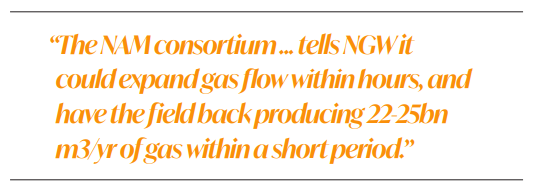Groningen: Europe’s ace in the hole? [Gas in Transition]
Europe is bracing for potentially a very difficult winter ahead, amid the looming threat that Russia could cut off gas supply to the continent entirely, in order to force concessions in the Ukraine war. Many EU member states are scrambling to advance new LNG import projects, some of which could be ready before the end of the heating season. But there is one key source of domestic gas that Europe has yet to tap on for extra supply, as despite the circumstances, doing so would present considerable political challenges.
The massive Groningen field in the Netherland first entered development in the 1960s, and at its peak in 1976, annual output came to 88bn m3. Even as recently as 2013, the field was still producing nearly 54bn m3. The problem was that, over Groningen’s many years of production, the field had been causing earthquakes that led to substantial damage in the surrounding area. Fortunately no deaths or injuries are understood to have occurred, but under mounting pressure from the local community, the Dutch government began capping the field’s output in 2014. And four years later, the government ordered its complete closure by the end of this decade.
Then in 2019, authorities decided to bring forward the shutdown to 2022. Output was restricted to 12bn m3 in the gas year commencing October 1, 2019, down from a cap of 19.4bn m3 in the previous year. The cap was lowered again to 8.1bn m3 in the year from October 1, 2020, and then to a mere 3.9bn m3 in October 1, 2021 to September 30, 2022, although the government subsequently doubled that to 7.6bn m3, in light of the worsening supply crunch in Europe. Its closure was also delayed to October 2023, and the government has left the door open for a further delay, although the production cap for October 1, 2022-September 30, 2023 is just 2.8bn m3.
The stakes
The NAM consortium comprising ExxonMobil and Shell tells NGW it could expand gas flow within hours, and have the field back producing 22-25bn m3/yr of gas within a short period. This would greatly benefit the Netherlands, which had its gas supply from Russia cut off at the end of May after the government refused to pay in rubles, and Europe as a whole, helping to bring down soaring prices.
Production from Groningen and other Dutch fields came to around 18.1bn m3 last year, equal to only half of the country’s consumption of 35.1bn m3. The country can import up to 12bn m3 of LNG from the Gate terminal, however, and accesses additional supplies from Norway and other neighbours. While the Netherlands has filled its gas storage facilities to 72% of capacity as of August 20, according to data published by Gas Infrastructure Europe, this stockpile still amounts to less than a quarter of its annual needs. It therefore remains vulnerable in the event of a particularly harsh winter, and if Russia cuts off supply to Europe entirely, limiting how much gas there is available for the continent as a whole. The government has already responded to the gas supply crunch by easing a cap on coal-fired power generation, and would likely increase coal burning further if the situation gets too severe, backtracking on its climate commitments.
A ramp-up in supply at Groningen would have even greater implications for Germany, which has been hit hard by Russia’s recent cuts in gas flow via Nord Stream 1. With the pipeline now restricted to only 20% capacity, there are early signals that the country is losing some political will to eliminate Russian gas imports. While the government has pledged to stop buying gas from Russia by mid-2024, with the help of several LNG import projects, some politicians outside the cabinet have even called for Nord Stream 2 to be allowed to flow gas. Wolfgang Kubicki, vice president of the Bundestag, on August 19 said the pipeline should be brought on stream so “people do not have to freeze in winter and that our industry does not suffer serious damage.”
Political initiative
What happens next is unclear, however. The NAM consortium has repeatedly stressed that the decision to restore output at Groningen lies with the government. The government in turn appears reluctant to make a choice that would bring about negative consequences for Groningen citizens. It seems, therefore, that this impasse can only be ended through a political initiative by the Groningen community.
“My view is that the Dutch government does not want to impose such a decision on its people because it has a legal obligation to phase out Groningen,” Thierry Bros. “The Groningen people, the Groningen town hall, should be the ones to start negotiating a split of the rent from the field.”
At today’s high gas prices, temporarily expanding Groningen’s gas supply could earn tens of billions of income per year, and some of that be dispersed to the affected population in the area. This could mean each Groningen citizen getting tens of thousands of euros, if they were granted a half, a third or even a quarter of rent from the field, according to Bros. Such a level of compensation would be hard for many to turn down.
The Netherlands would also earn valuable political capital with Germany and the rest of Europe, for helping the continent ease the supply crunch, Bros says, potentially averting public unrest and limiting the economic fallout from the crisis. Put in context, having production at Groningen running at 20-25 bcm per year would mean an extra 1.0-1.5bn m3/month for Europe. Following steep cuts in its supply already in recent months, Russian gas flow to Europe was already at a record low of 3.6 bcm in July. Restoring Groningen would therefore go a significant way towards offsetting a potential total disruption in Russian gas. But negotiations between the Dutch government, the local community and the project’s operators would take time, and winter is fast-approaching.



